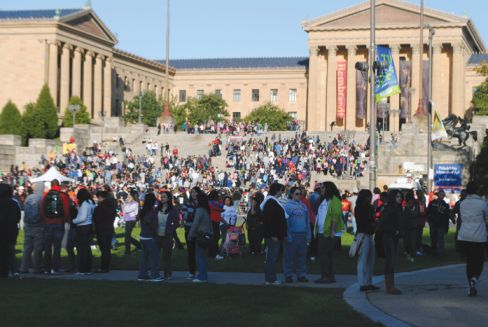
A sea of people in red washed up on the legendary Philadelphia Art Museum steps as the 25th- annual AIDS Walk and Run was in full swing on Sunday, Oct. 16.
For 25 years, people from all over the greater Philadelphia area and beyond came to step up to the challenge of completing an 8K walk down Kelly Drive and returned on Martin Luther King Drive Sunday morning. Nearly 15,000 people walked and raised a total of $350,000 for the cause.
The walk also marked 30 years since AIDS was discovered.
“As a nation and as a city, these are statistics that we should find alarming,” Robb Reichard, executive director of the AIDS Fund, said according to a press release given by the fund. “We want to educate the entire community about the epidemic and its current state and offer perspective of how the disease has changed over the past 30 years.”
The walk also had quilts set up by the National Art Project neatly laid out across the front steps of the Art Museum. Started by the NAMES Project in June of 1987, each panel on the quilts represented a person who has died of AIDS in the Philadelphia area. Each quilt measures six feet long, which represents the size of a coffin and the AIDS Walk Fund used 44,000 panels. The friends and family members of the victims on the panels made the quilts.
Cari Feiler Bender, public relations consultant and president of relief communications, said the quilts were a “great personal way to show how much AIDS affects us all and are great conversation starters.” Bender also said the quilts embodies something that “people don’t want to necessarily talk about.”
Bender also went on to say how the walk is huge step for a change. “One person can make a difference and it also encourages others to do the same. The statistics are alarming with one in five people infected not even knowing that they have HIV. With this walk, the participants are showing that it’s good to use cleaner needles, it’s good to use condoms, it’s good to get tested.”
Human Immunodeficiency Virus (HIV) is a virus that attacks and breaks down a person’s immune system. When the immune system breaks down, then the body loses its ability to fight off the virus and contamination. Acquired Immune Deficiency Syndrome (AIDS) is the deadly disease that people with HIV advance to if tests show that the immune system has been severely injured by the virus. HIV can be transmitted from person to person with specific bodily fluids such as blood, semen, vaginal fluids or breast milk from an infected person. There are 30,000 people living with HIV in the greater Philadelphia area according to the Philadelphia Department of Health, and Philadelphians are infected at five times the national rate, more than 50 percent higher than the residents of New York City.
The AIDS Fund started out with a run that began at 8 a.m. with the walk following at 9 a.m. Along with the Philadelphians, Cabrini College’s sorority and fraternity came out for the great cause. Sophomore early childhood education major Alyssa Grenyer was not only there for the walk but to also get a great feel for the City of Brotherly Love. “I really enjoyed the walk because I got to get an outside experience of Philadelphia,” Grenyer said. “It’s such a beautiful city and I loved spending the day with my sisters that I don’t normally see.”
Along the walk were signs showing a certain event that occurred each year. Years from 1980 to 2011 were shown all throughout Kelly Drive and people were stunned by the statistics.
The walk ended on a remarkable note with a cheery crowd greeting the walkers as they got to the finish line. The next AIDS Walk will be held next year on Oct. 21 and Bender finds this one is going to be just as good as the first.
“I’ve done this walk eight times and every year it gets better,” Bender said. “When it first started, only 300 people showed up and we only raised $33,000. So you can see that one person, in which case the first 300 people made a change and that’s what we’re seeking for and this is what the AIDS fund is all about.”


